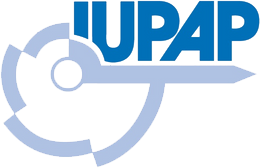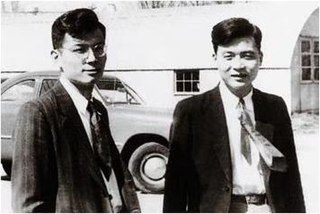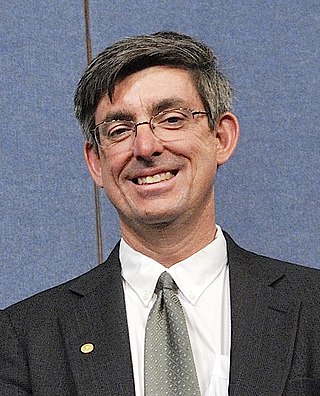Related Research Articles

Condensed matter physics is the field of physics that deals with the macroscopic and microscopic physical properties of matter, especially the solid and liquid phases, that arise from electromagnetic forces between atoms and electrons. More generally, the subject deals with condensed phases of matter: systems of many constituents with strong interactions among them. More exotic condensed phases include the superconducting phase exhibited by certain materials at extremely low cryogenic temperatures, the ferromagnetic and antiferromagnetic phases of spins on crystal lattices of atoms, the Bose–Einstein condensates found in ultracold atomic systems, and liquid crystals. Condensed matter physicists seek to understand the behavior of these phases by experiments to measure various material properties, and by applying the physical laws of quantum mechanics, electromagnetism, statistical mechanics, and other physics theories to develop mathematical models and predict the properties of extremely large groups of atoms.
Metallic hydrogen is a phase of hydrogen in which it behaves like an electrical conductor. This phase was predicted in 1935 on theoretical grounds by Eugene Wigner and Hillard Bell Huntington.

The International Union of Pure and Applied Physics is an international non-governmental organization whose mission is to assist in the worldwide development of physics, to foster international cooperation in physics, and to help in the application of physics toward solving problems of concern to humanity. It was established in 1922 and the first General Assembly was held in 1923 in Paris. The Union is domiciled in Geneva, Switzerland.
David Shoenberg, was a British physicist who worked in condensed matter physics. Shoenberg is known for having developed experimental and theoretical principles to study the De Haas–Van Alphen effect to characterize the electrical conduction of metals.
A quantum critical point is a point in the phase diagram of a material where a continuous phase transition takes place at absolute zero. A quantum critical point is typically achieved by a continuous suppression of a nonzero temperature phase transition to zero temperature by the application of a pressure, field, or through doping. Conventional phase transitions occur at nonzero temperature when the growth of random thermal fluctuations leads to a change in the physical state of a system. Condensed matter physics research over the past few decades has revealed a new class of phase transitions called quantum phase transitions which take place at absolute zero. In the absence of the thermal fluctuations which trigger conventional phase transitions, quantum phase transitions are driven by the zero point quantum fluctuations associated with Heisenberg's uncertainty principle.

Yttrium arsenide is an inorganic compound of yttrium and arsenic with the chemical formula YAs. It can be prepared by reacting yttrium and arsenic at high temperature. Some literature has done research on the eutectic system of it and zinc arsenide.
The Boltzmann Medal is a prize awarded to physicists that obtain new results concerning statistical mechanics; it is named after the celebrated physicist Ludwig Boltzmann. The Boltzmann Medal is awarded once every three years by the Commission on Statistical Physics of the International Union of Pure and Applied Physics, during the STATPHYS conference.

Volker Heine FRS is a New Zealand / British physicist. He is married to Daphne and they have three children. Volker Heine is considered a pioneer of theoretical and computational studies of the electronic structure of solids and liquids and the determination of physical properties derived from it.
The Pandya theorem is a good illustration of the richness of information forthcoming from a judicious use of subtle symmetry principles connecting vastly different sectors of nuclear systems. It is a tool for calculations regarding both particles and holes.

The 122 iron arsenide unconventional superconductors are part of a new class of iron-based superconductors. They form in the tetragonal I4/mmm, ThCr2Si2 type, crystal structure. The shorthand name "122" comes from their stoichiometry; the 122s have the chemical formula AEFe2Pn2, where AE stands for alkaline earth metal (Ca, Ba Sr or Eu) and Pn is pnictide (As, P, etc.). These materials become superconducting under pressure and also upon doping. The maximum superconducting transition temperature found to date is 38 K in the Ba0.6K0.4Fe2As2. The microscopic description of superconductivity in the 122s is yet unclear.

Photofission is a process in which a nucleus, after absorbing a gamma ray, undergoes nuclear fission and splits into two or more fragments.
Narendra Kumar was an Indian theoretical physicist and a Homi Bhaba Distinguished Professor of the Department of Atomic Energy at Raman Research Institute. He was also an honorary professor at Jawaharlal Nehru Centre for Advanced Scientific Research.

Hong Chaosheng was a Chinese physicist best known for studying cryogenics. Hong was the teacher of Zhao Zhongxian, a laureate of Highest Science and Technology Award, the highest scientific award issued by the Chinese Academy of Sciences to scientists working in China.
Oxyarsenides or arsenide oxides are chemical compounds formally containing the group AsO, with one arsenic and one oxygen atom. The arsenic and oxygen are not bound together as in arsenates or arsenites, instead they make a separate presence bound to the cations (metals), and could be considered as a mixed arsenide-oxide compound. So a compound with OmAsn requires cations to balance a negative charge of 2m+3n. The cations will have charges of +2 or +3. The trications are often rare earth elements or actinides. They are in the category of oxypnictide compounds.

NA64 experiment is one of the several experiments at CERN's Super Proton Synchrotron (SPS) particle collider searching for dark sector particles. It is a fixed target experiment in which an electron beam of energy between 100-150 GeV, strikes fixed atomic nuclei. The primary goal of NA64 is to find unknown and hypothetical particles such as dark photons, axions, and axion-like particles.
The current state of quantum computing is referred to as the noisy intermediate-scale quantum (NISQ) era, characterized by quantum processors containing up to 1,000 qubits which are not advanced enough yet for fault-tolerance or large enough to achieve quantum advantage. These processors, which are sensitive to their environment (noisy) and prone to quantum decoherence, are not yet capable of continuous quantum error correction. This intermediate-scale is defined by the quantum volume, which is based on the moderate number of qubits and gate fidelity. The term NISQ was coined by John Preskill in 2018.
A Coulomb crystal is a collection of trapped ions confined in a crystal-like structure at low temperature. The structures represent an equilibrium between the repulsive Coulomb interaction between ions and the electric and magnetic fields used to confine the ions. Depending on the confinement techniques and parameters, as well as the number of ions in the trap, these can be 1-, 2- or 3-dimensional, with typical spacing between ions of ~10μm, which is significantly larger than typical solid-state crystal structures. Outside of ion traps, Coulomb crystals also occur naturally in celestial objects such as neutron stars.

John Louis Sarrao is an American physicist. He was the deputy director for science, technology, and engineering at Los Alamos National Laboratory. As of 2 October 2023, he became the sixth director of SLAC National Accelerator Laboratory
GrigoryEfimovich Volovik is a Russian theoretical physicist, who specializes in condensed matter physics. He is known for the Volovik effect.
References
- ↑ Kes, Peter (2009). "The 25th International Conference on Low Temperature Physics; Report from the Organizers". J. Phys.: Conf. Ser. 150: 001002. doi: 10.1088/1742-6596/150/0/001002 .
- ↑ "LT25 committees, sponsors and exhibitors, some conference statistics, and a list of previous LT conferences". J. Phys.: Conf. Ser. 150: 001004. 2009. doi: 10.1088/1742-6596/150/0/001004 .
- ↑ "QFS98".
- ↑ "29th International Conference on LOW TEMPERATURE PHYSICS | 第29回低温物理学国際会議". www.lt29.jp. Retrieved 2023-10-14.
- ↑ "LT Conferences". ltl.tkk.fi. Retrieved 2023-10-12.
- ↑ Donnelly, Russell J. (1994-02-02). "LT-20 Proceedings: Introduction". Physica B: Condensed Matter. 194–196: vii–viii. doi:10.1016/0921-4526(94)90326-3. ISSN 0921-4526.
- ↑ Slater, John C. (1949-11-04). "The MIT International Conference on the Physics of Very Low Temperatures, September 6-10, 1949". Science. 110 (2862): 465–467. doi:10.1126/science.110.2862.465. ISSN 0036-8075.
- ↑ Yaqub, M. (1965-01-01). "Low temperature physics". Physics Today. 18 (1): 56–64. doi:10.1063/1.3047155. ISSN 0031-9228.
- ↑ "IUPAP: C5: Report 2002". archive.iupap.org. Retrieved 2023-10-14.
- ↑ Takano, Yasu; Hershfield, S. P.; Hirschfeld, P. J.; Goldman, A. M.; University of Florida, eds. (2006). Low temperature physics: 24th International Conference on Low Temperature Physics, LT 24, Orlando, Florida, 10 - 17 August 2005. Pt. B. AIP conference proceedings. Melville, NY: AIP Press. ISBN 978-0-7354-0347-5.
- ↑ Kes, Peter; Jochemsen, Reijer (2009-04-22). "Proceedings of the 25th International Conference on Low Temperature Physics (LT25) (Amsterdam, The Netherlands, 6–13 August 2008)". Journal of Physics: Condensed Matter. 21 (16): 160301. doi: 10.1088/0953-8984/21/16/160301 . ISSN 0953-8984.
- ↑ Liu, W M; Wang, N L; Xiang, T; Lu, L; He, Y S; Luo, J (2012-12-17). "26th International Conference on Low Temperature Physics (LT26)". Journal of Physics: Conference Series. 400 (00): 001001. doi: 10.1088/1742-6596/400/0/001001 . ISSN 1742-6588.
- ↑ Calzetta, Esteban (2014-12-08). "27th International Conference on Low Temperature Physics (LT27)". Journal of Physics: Conference Series. 568 (00): 001001. doi: 10.1088/1742-6596/568/1/001001 . ISSN 1742-6588.
- ↑ "28th International Conference on Low Temperature Physics (LT28)". Journal of Physics: Conference Series. 969: 011002. 2018-04-19. doi: 10.1088/1742-6596/969/1/011002 . ISSN 1742-6588.
- ↑ "29th International Conference on LOW TEMPERATURE PHYSICS | 第29回低温物理学国際会議". www.lt29.jp. Retrieved 2023-10-14.
- ↑ "30th International Conference on LOW TEMPERATURE PHYSICS – 7-14 August 2025, Bilbao, Spain" (in Spanish). Retrieved 2023-10-14.
- ↑ "About". IUPAP. Archived from the original on 2012-01-06. Retrieved 2012-01-05.
- ↑ "Fritz London Memorial Prize". Phy.duke.edu. Retrieved 2014-04-15.
- ↑ Brickwedde, F. G. (1958-03-01). "Introducing the Fritz London Award". Physics Today. 11 (3): 16–17. doi:10.1063/1.3062445. ISSN 0031-9228.
- ↑ for the full list, see http://www.iop.org/activity/groups/subject/lt/prize/page_44359.html Archived 2016-12-20 at the Wayback Machine
- ↑ "Fritz London Memorial Prize | Department of Physics". physics.duke.edu. Retrieved 2023-10-10.
- ↑ Roberts L (1965). "Presentation Address for the Fourth London Award". In Daunt JG, et al. (eds.). Low Temperature Physics LT9: Proceedings of the IXth International Conference on Low Temperature Physics. Springer Science+Business Media, LLC. pp. 663–664. doi:10.1007/978-1-4899-6443-4. ISBN 978-1-4899-6217-1.